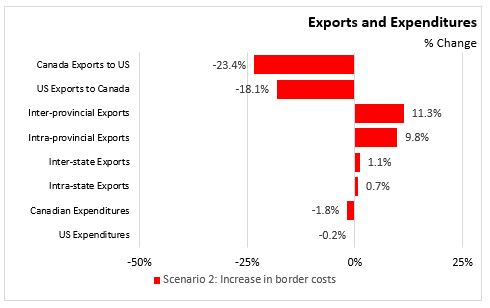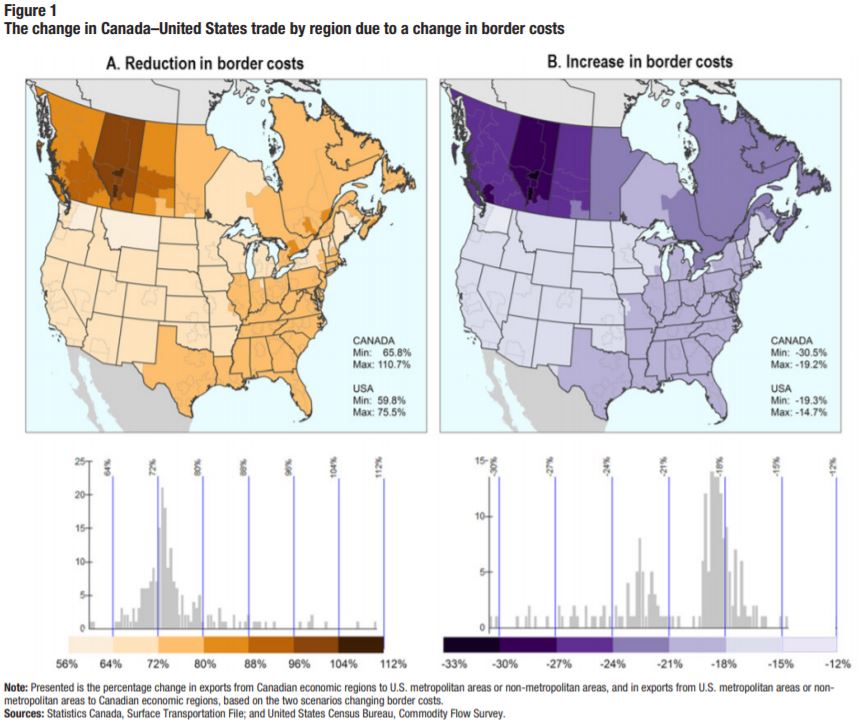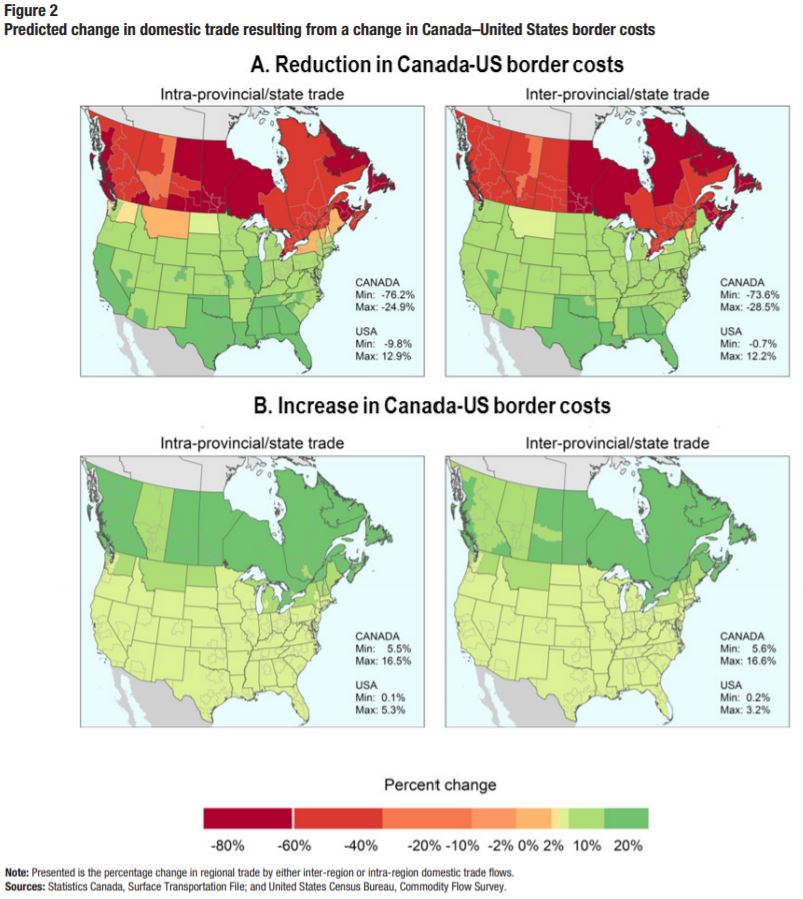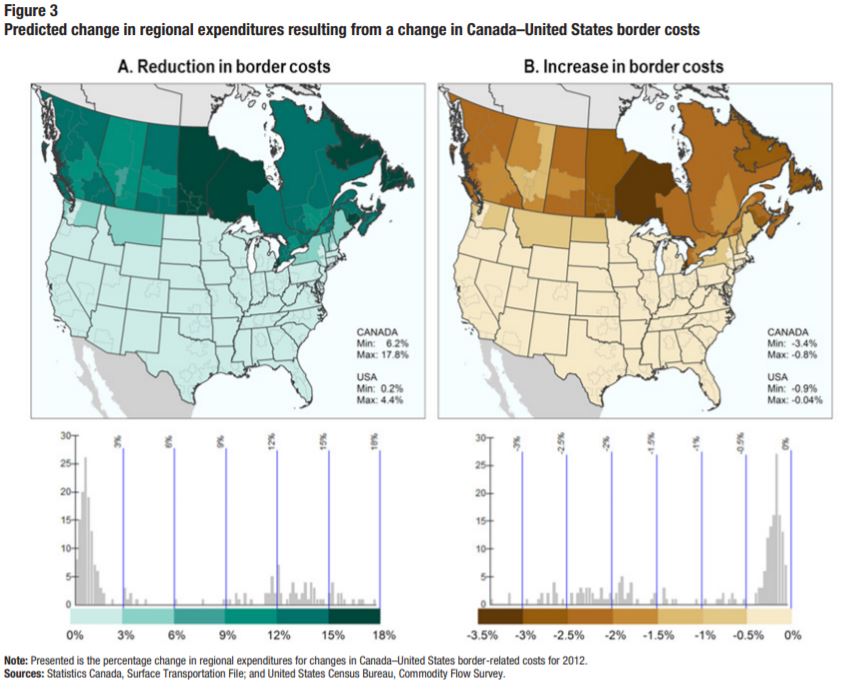The Economics and Statistics Division maintains archives of previous publications for accountability purposes, but makes no updates to keep these documents current with the latest data revisions from Statistics Canada. As a result, information in older documents may not be accurate. Please exercise caution when referring to older documents. For the latest information and historical data, please contact the individual listed to the right.
<--- Return to Archive
For additional information relating to this article, please contact:
June 17, 2019STUDY: THE EFFECT OF CHANGING CANADA–UNITED STATES BORDER COSTS ON NORTH AMERICAN TRADE PATTERNS AND EXPENDITURES Statistics Canada recently published an article on the impacts of changing trade costs at the Canada-US border. Border costs have traditionally included tariffs, non-tariff measures such as quotas, and trade frictions caused by factors such as regulations, time delays and policy uncertainty. The study goes beyond national level analysis to show regional effects of changing border-related costs. Maps used to depict how increases and decreases in border frictions affect trade show considerable regional variation when conditions at the border change.
The border cost estimates are based on data from Statistics Canada’s Surface Transportation File (STF) and the U.S. Commodity Flow Survey (CFS). The dataset covers trade within and between all provinces and states, and between 201 sub-provincial and sub-state regions for 2012. The data allows for estimating border-related frictions generated by the Canada–US border and borders between provinces. The results suggest that the combined tariff and non-tariff cost are equivalent to an average tariff of 30 per cent at the Canada–US border and 10 per cent inter-provincial borders.
Changing Border Costs
The study explores two hypothetical scenarios for changing cost at the US-Canada border. The first assumes the border cost between Canada and the United States declines to the provincial border cost of 10 per cent. The second scenario attempts to quantify the effects of Canada and the United States withdrawing from a regional trade agreement (i.e. NAFTA) and being governed by World Trade Organization rules and most-favoured-national tariff levels. Using results from previous studies, trade costs are increased 6 percentage points to a 36% tariff equivalent in the second scenario. The two counterfactual scenarios are simulated with a structural gravity trade model to examine how the change in trade costs would impact trading patterns and for welfare (measured by changes in total expenditures in each economy).


Results suggest that reducing the cost of the Canada-US border from 30 to 10 per cent will lead to an 82.2 per cent increase in exports from Canada to the United States, a 52.0 per cent decrease in inter-provincial exports, and a 46.1 per cent decline in intra-provincial exports. In addition, expenditure on domestic and imported non-energy goods increases 11.4% in Canada.
Estimates also suggest that increasing the Canada-US border cost from 30 to 36 per cent would reduce Canadian exports to the United States by 23.4 per cent and increase trade within Canada with inter-provincial exports rising 11.3 per cent and intra-provincial trade increasing 9.8 per cent. The authors also find that the higher border cost would reduced non-energy goods expenditures by 1.8 per cent (approximately $10 billion CAD in 2012).

The results of the study, shown in maps by economic region, suggest that under scenario 1 Nova Scotia exports in regions outside Halifax to the US would increase within the range of 72 to 80 per cent, while within the Halifax region exports would increase by between 80 to 88 per cent. Reduction in Nova Scotia’s interprovincial exports and intraprovincial trade occur in the scenario as more is traded with the US. These maps also show that with border costs increasing under scenario 2, Nova Scotia exports to the US decline by 21 to 24 per cent. Interprovincial and intraprovincial trade increases in Nova Scotia under scenario 2.

Results also show that reduced border costs in the first scenario lead to less internal trade in Canada. The expected decline in western provinces arises more from a change in intra-provincial flows, while the eastern provinces would be expected to switch more from inter-provincial to international trade.
Additional maps produced by the study suggest that under scenario 1, Nova Scotia interprovincial trade among regions outside Halifax would decrease by between 60 to 80 per cent, while trade between Halifax region and other provinces is expected to decrease between 40 to 60 per cent. Intra-provincial trade in Nova Scotia declines 40 to 60 per cent given the trade cost reduction under scenario 1.
Scenario 2 results suggest that higher trade costs will increase trade between Nova Scotia and other provinces by 10 to 20 per cent. Furthermore, regions outside of Halifax appear to increase intra-provincial trade by 10 to 20 percent, while within-province trade for the Halifax region appears to increase by an estimate in the range of 2 to 10 per cent.

Results for scenario 2 also show that the increased border cost reduces Canadian non-energy goods expenditures by 1.5 to 3.5 per cent, with the centre of Canada most affected. Under scenario 1, expenditures for non-energy goods in Nova Scotia increase 12 to 15 per cent outside Halifax region, compared to 9 to 12 per cent inside Halifax – indicating a welfare gain for Nova Scotia in this scenario. Increased border costs under scenario 2 lowers expenditures in Nova Scotia, with the decline estimated to be in the range of 1.5 to 2.5 per cent.
Daily release | Full article
<--- Return to Archive